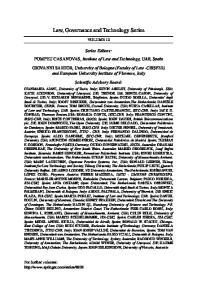Computers, Privacy and Data Protection: an Element of Choice
Privacy and data protection have never been static. On the contrary, the history of the last 40 years shows the reverse. New issues and challenges continue to emerge, requiring an ongoing process of interpreting their effect in terms of reach, objectives
- PDF / 6,131,943 Bytes
- 463 Pages / 439.37 x 666.142 pts Page_size
- 9 Downloads / 329 Views
Serge Gutwirth · Yves Poullet · Paul De Hert · Ronald Leenes Editors
Computers, Privacy and Data Protection: an Element of Choice
123
Editors Serge Gutwirth Vrije Universiteit Brussel Center for Law, Science, Technology & Society Studies (LSTS) Pleinlaan 2 1050 Brussels Belgium [email protected] Prof. Paul De Hert Vrije Universiteit Brussel Center for Law, Science, Technology & Society Studies (LSTS) Pleinlaan 2 1050 Brussels Belgium [email protected]
Prof. Yves Poullet University of Namur Research Centre for Information Technology & Law Rempart de la Vierge 5 5000 Namur Belgium [email protected] Ronald Leenes Tilburg University TILT Warandelaan 2 5037 AB Tilburg Netherlands [email protected]
ISBN 978-94-007-0640-8 e-ISBN 978-94-007-0641-5 DOI 10.1007/978-94-007-0641-5 Springer Dordrecht Heidelberg London New York Library of Congress Control Number: 2011922121 © Springer Science+Business Media B.V. 2011 No part of this work may be reproduced, stored in a retrieval system, or transmitted in any form or by any means, electronic, mechanical, photocopying, microfilming, recording or otherwise, without written permission from the Publisher, with the exception of any material supplied specifically for the purpose of being entered and executed on a computer system, for exclusive use by the purchaser of the work. Printed on acid-free paper Springer is part of Springer Science+Business Media (www.springer.com)
Preface
Privacy and data protection have never been static. On the contrary, the history of the last 40 years shows the reverse. Even if some important parts of the legislative framework – such as the EC Data Protection Directive of 1995 – have remained unaltered, new issues and challenges continue to emerge, requiring an ongoing process of interpreting their effect in terms of reach, objectives and their deeper significance. Such new issues do also trigger the elaboration of more specifically targeted legislative interventions that do not always fit seamlessly into the preexisting framework. But this is not a surprising picture, since the developments, which resort under the denominators of privacy and data protection are generating and challenging the concerns of numerous different stakeholders who effectively use their voices and power to transform those concerns into political issues. Moreover, the number of factors and actors that sensibly impact upon privacy and data protection are manifold. Indeed, the consequences of technological applications due to unprecedented storage, processing and transmission capacities and by the possibilities of miniaturisation, convergence, interoperability and ubiquity, represent powerful triggers and challenges of emerging developments, but they are not the only determining factor. The current developments in the field are also linked to many other sources of action and change, such as business models, security policies, population management, police work and law enforcement, leisure, culture, health policies, practices in the “real” and in the “virtua
Data Loading...











